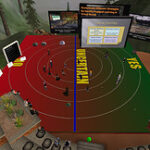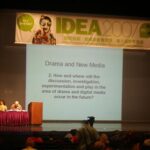 Yesterday morning in Perth I presented the final workshop in the New Media Consortium Symposium on New Media and Learning. The session went quite well but I did experience one small glitch and had to reload the software.. they was a delay of a minute or two… as is often the case when you’re excited about new ideas and new ways of working I think I tried to cram too much into the 45 minute slot. Trying to present theory and engage participants in some practical articulations of that theory proved exciting and I think I erred too much on the side of teacher talk. Having said that, the feedback I’ve had so far is very encouraging.
Yesterday morning in Perth I presented the final workshop in the New Media Consortium Symposium on New Media and Learning. The session went quite well but I did experience one small glitch and had to reload the software.. they was a delay of a minute or two… as is often the case when you’re excited about new ideas and new ways of working I think I tried to cram too much into the 45 minute slot. Trying to present theory and engage participants in some practical articulations of that theory proved exciting and I think I erred too much on the side of teacher talk. Having said that, the feedback I’ve had so far is very encouraging.
Larry Johnson took the stage when I was finished and made his closing remarks – which thanks to the NMC’s Creative Commons license, I’ve made available below.
Closing Remarks: 2009 New Media and Learning Symposium | nmc
Play Now
Larry Johnson
I must confess to a bit of melancholy as I stand here. On the one hand, it’s an altogether pleasant duty and one that I enjoy. On the other, it means that the sessions have drawn to a close, the speakers are done, and the conference is all but over.
Yet, it is also not over.
It seems powerfully clear that the ideas and conversations that have surfaced over the past two days will outlive our shared experience. You have blogged and tweeted about what you saw here, you have posted photos to Flickr and beyond, and you have added new names and new friends to the lists of people you admire. The conversations started here will continue beyond today because we have this experience in common.
That theme — the compelling power of new media to connect us to one another and to extend our experiences beyond time and place — has run throughout this conference. Like a thread in a tapestry, it has run through and connected every one of the sessions.
Nettrice Gaskins and Lori Landay spoke eloquently in yesterday’s keynote about experimenting with space as a form of expression. They uniquely understand the nature of that thread at a very deep level. Lori’s machinima in which the metaphor of falling conveyed her relationship to place as an almost tangible medium, and her conviction that one’s sense of self comes not so much from surface perceptions, but from the inseparable context of our shared experiences and the spaces in which they occur.
In his compelling keynote this morning, Eric Hackathorn emphasized the importance of social networking as a force for change , demonstrating that the simplest tools can have powerful and lasting effects when they are used to connect us to one another.
Session after session has reinforced that new media is not about tools, but about the ways they link us together.
As practitioners of new media, we seem to just naturally document everything we do, whether in a 140-character tweet or in a video or in photographs. We do this almost automatically, without thinking about how or sometimes even why we are doing it.
The media themselves are just part of what we want to say, how we reach out to one another. They are context, and they are glue.
We carry cameras everywhere; we take pictures. We make videos. We use our phones to access our social networks wherever we happen to be. We live our lives with the expectation that there will always be rich, multilayered documentation of our experiences, so that we can reflect on them and so we can share them with those who were not there to share in the original experience. Seeing our own reflections alongside those of others reinforces the fact that we did not have those experiences alone, but together, as part of a community, a group. We document our social experiences in ways that are very much part of our humanity, tapping something deep in all of us.
In their sessions, Joe Tojek, Jared Bendis, Anu Vedantham and Peter Decherney showed us some of the ways they teach their students the skills to do this — through storyboarding, mashups, and through original videos.
Other speakers demonstrated how simple tools can be used to great effect; Anthony Armstrong encourages skills in his students like critical thinking, debate, and collaboration, using freely available tools that are easy to set up and work with. Beth Ritter-Guth combines the flat web and 3D virtual space using Google applications. Joe Russo used a new and powerful way of thinking about pen and paper to draw his students into reflective thinking and deeper understanding.
Teacher-performers like Tom Benton and Kim Flintoff showed us that when creative expression, social networking, and learning are in harmony, remarkable things can happen.
Dance, drama, music, and the visual arts increasingly resonate and inform our use of new media, with ever more engaging and beautiful results. Those of you who had the opportunity to fly with the Skydancers last night know this firsthand — after experiencing four kilometers of incredible art as skilled performers moved seamlessly through that vast three-dimensional space, I’m sure your notions of boundaries expanded just as mine did.
This morning, we went on a virtual field trip and left one virtual world to see another in the first public glimpse of the Hakone Project. Many commented that that environment is itself a work of art: a creative expression of space that in turn becomes a space for creative experiences. That has been a persistent theme here. The very first meeting that the NMC held in Second Life back in 2006 asked the question: What is art in a world made of art? The answer, we’ve learned over those intervening years, is complex and multilayered. As we get nearer to the horizon of what we know is possible, it morphs and shifts and pulls us in a new direction.
New media increasingly provides the forum for us to explore boundaries between the virtual and the real, boundaries that are ever permeable and always a little hazy, as we saw in John Fillwalk’s work with hybrid reality and in the simulated training sessions demonstrated by Cynthia Calongne. In both of their work, the space in which the experience takes place ebbs and flows from the physical world to the virtual one. New media tools set the stage for students to work with this flow, to travel between the real and the virtual, and to reflect on and document their journey.
They led us, but none of us created or experienced the events of the past two days alone.
We came together as a group, and as a group we saw our many diverse individual impressions come together as well into a single shared experience — an experience that affected each of us in different ways, but one that is so much richer for having been built by all of us.
That’s the true takeaway for me from this symposium: that new media can connect us to one another and enlarge our individual experiences in ways we can only begin to imagine.
That’s where the true opportunity lies: to realize that we have now reached a point where new media is so much a part of our lives, so natural, it is almost like air to us — yet at the same time, this is not a universal experience. These same media and these same connections are too often lacking in the worlds of work and learning, and I have to ask myself — what is being lost by that choice?
To me, it is powerfully clear that the simple answer is, too much. Our task must be to employ the social power of new media in the service of work and learning communities, and to enrich these experiences by doing so just as we do in our social communities.
This conference, the annual Symposium on New Media & Learning, was convened precisely because we see that task as so important.
We recognize that the tools will change. But we also realize that whatever the tools may be, they simply support the experiences, reflections, and social connections that are at the heart of how we learn. Those things matter.
They matter because they are reflections of all of us. Everyone here has contributed to this conference, making it so much more than it would have been otherwise. We thank all of you.
Thanks are also due to all the presenters, to all the people behind the scenes manning the help desks and organizing sessions. Thanks as well to our collaborators Learning Times, and to all the NMC staff who worked tirelessly to make this happen — and thanks to all of you in the audience who brought so much by joining us.
We are enriched by all your contributions, and humbled by all we have learned.
It has been a fantastic two days.
The 2009 NMC Symposium on New Media & Learning is now, officially, adjourned.
Larry Johnson
The New Media ConsortiumMarch 26, 2009
Larry JohnsonSee Also: http://www.nmc.org/2009-nml-symposium
Attachment Size 2009-nml-closing-remarks.pdf 29.58 KB
Related articles by Zemanta
- ELI Podcast: The 2009 Horizon Report (downes.ca)
- Your Brave Predictions! (downes.ca)
- 2009 Horizon Report (downes.ca)

![Reblog this post [with Zemanta]](http://img.zemanta.com/reblog_a.png?x-id=4c93737a-7ea9-8171-8299-5eda6d392e3e)





